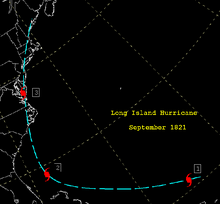 Estimated track of the 1821 Norfolk and Long Island Hurricane from NOAA. | |
| Meteorological history | |
|---|---|
| Formed | Unknown |
| Dissipated | September 4, 1821 |
| Category 4 major hurricane | |
| 1-minute sustained (SSHWS/NWS) | |
| Highest winds | ≥130 mph (≥215 km/h) |
| Lowest pressure | <965 mbar (hPa); <28.50 inHg (estimated) |
| Overall effects | |
| Fatalities | ≥22 direct |
| Injuries | Unknown |
| Damage | $200,000 (1821 USD) |
| Areas affected | East Coast of the United States, (especially North Carolina and Delmarva Peninsula) |
| [1] | |
Part of the 1821 Atlantic hurricane season | |
The 1821 Norfolk and Long Island Hurricane was an intense and record breaking tropical cyclone that devastated the East Coast of the United States in early September & was one of four known tropical cyclones that have made landfall in New York City. It has been estimated that a similar hurricane would cause about $250 billion in damages if a similar storm were to occur in 2014.[2] Despite that, an even earlier and more intense hurricane struck the greater area during the pre-Columbian era (between 1278 and 1438) which left evidence that was detected in South Jersey via paleotempestological research.[3] A third and more recent storm was the 1893 New York hurricane, while the fourth was Hurricane Irene in 2011.
The storm was the first of three tropical cyclones recorded in the 1821 Atlantic hurricane season, and was first observed off the southeast United States coast on September 1 likely as a major hurricane. It then moved ashore near Wilmington, North Carolina during the late part of September 2. It then passed near Norfolk, Virginia before moving striking the Delmarva Peninsula and New Jersey on September 3. Shortly after, the hurricane struck modern day Jamaica Bay, which would later become part of New York City. The storm was last observed over New England on September 4, just 6 years after the destructive Great September Gale of 1815.
- ^ F.P. Ho. "The Norfolk and Long Island Hurricane – Sept. 3-4 – Pt. 2" (PDF). Retrieved 2007-07-02.
- ^ "Chilling insurance company report: Forget Hurricane Sandy, worst is yet to come". Shore News Today. September 29, 2014. Archived from the original on 2018-04-02. Retrieved April 2, 2018.
- ^ Donnelly, Jeffrey P.; et al. (2001). "Sedimentary evidence of intense hurricane strikes from New Jersey". Geology. 29 (7): 615–618. Bibcode:2001Geo....29..615D. doi:10.1130/0091-7613(2001)029<0615:SEOIHS>2.0.CO;2.
